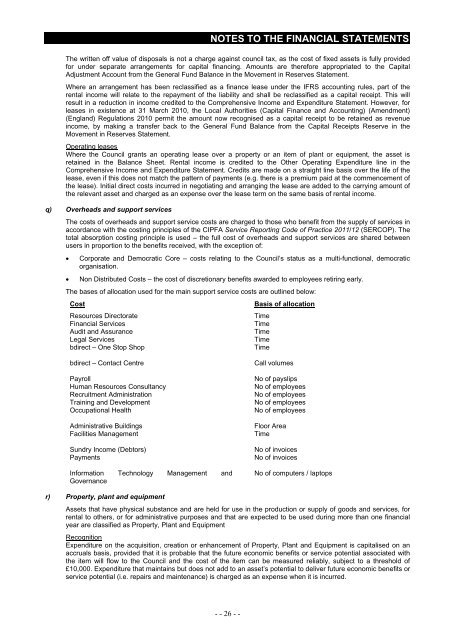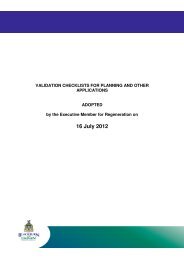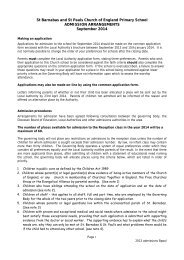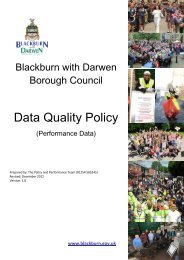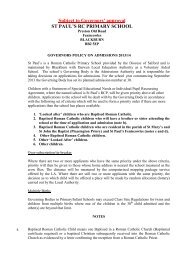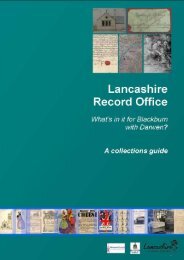Statement of Accounts 2011/2012 - Blackburn with Darwen Borough ...
Statement of Accounts 2011/2012 - Blackburn with Darwen Borough ...
Statement of Accounts 2011/2012 - Blackburn with Darwen Borough ...
Create successful ePaper yourself
Turn your PDF publications into a flip-book with our unique Google optimized e-Paper software.
NOTES TO THE FINANCIAL STATEMENTS<br />
The written <strong>of</strong>f value <strong>of</strong> disposals is not a charge against council tax, as the cost <strong>of</strong> fixed assets is fully provided<br />
for under separate arrangements for capital financing. Amounts are therefore appropriated to the Capital<br />
Adjustment Account from the General Fund Balance in the Movement in Reserves <strong>Statement</strong>.<br />
Where an arrangement has been reclassified as a finance lease under the IFRS accounting rules, part <strong>of</strong> the<br />
rental income will relate to the repayment <strong>of</strong> the liability and shall be reclassified as a capital receipt. This will<br />
result in a reduction in income credited to the Comprehensive Income and Expenditure <strong>Statement</strong>. However, for<br />
leases in existence at 31 March 2010, the Local Authorities (Capital Finance and Accounting) (Amendment)<br />
(England) Regulations 2010 permit the amount now recognised as a capital receipt to be retained as revenue<br />
income, by making a transfer back to the General Fund Balance from the Capital Receipts Reserve in the<br />
Movement in Reserves <strong>Statement</strong>.<br />
Operating leases<br />
Where the Council grants an operating lease over a property or an item <strong>of</strong> plant or equipment, the asset is<br />
retained in the Balance Sheet. Rental income is credited to the Other Operating Expenditure line in the<br />
Comprehensive Income and Expenditure <strong>Statement</strong>. Credits are made on a straight line basis over the life <strong>of</strong> the<br />
lease, even if this does not match the pattern <strong>of</strong> payments (e.g. there is a premium paid at the commencement <strong>of</strong><br />
the lease). Initial direct costs incurred in negotiating and arranging the lease are added to the carrying amount <strong>of</strong><br />
the relevant asset and charged as an expense over the lease term on the same basis <strong>of</strong> rental income.<br />
q) Overheads and support services<br />
The costs <strong>of</strong> overheads and support service costs are charged to those who benefit from the supply <strong>of</strong> services in<br />
accordance <strong>with</strong> the costing principles <strong>of</strong> the CIPFA Service Reporting Code <strong>of</strong> Practice <strong>2011</strong>/12 (SERCOP). The<br />
total absorption costing principle is used – the full cost <strong>of</strong> overheads and support services are shared between<br />
users in proportion to the benefits received, <strong>with</strong> the exception <strong>of</strong>:<br />
• Corporate and Democratic Core – costs relating to the Council’s status as a multi-functional, democratic<br />
organisation.<br />
• Non Distributed Costs – the cost <strong>of</strong> discretionary benefits awarded to employees retiring early.<br />
The bases <strong>of</strong> allocation used for the main support service costs are outlined below:<br />
Cost<br />
Basis <strong>of</strong> allocation<br />
Resources Directorate<br />
Time<br />
Financial Services<br />
Time<br />
Audit and Assurance<br />
Time<br />
Legal Services<br />
Time<br />
bdirect – One Stop Shop<br />
Time<br />
bdirect – Contact Centre<br />
Payroll<br />
Human Resources Consultancy<br />
Recruitment Administration<br />
Training and Development<br />
Occupational Health<br />
Administrative Buildings<br />
Facilities Management<br />
Sundry Income (Debtors)<br />
Payments<br />
Information Technology Management and<br />
Governance<br />
Call volumes<br />
No <strong>of</strong> payslips<br />
No <strong>of</strong> employees<br />
No <strong>of</strong> employees<br />
No <strong>of</strong> employees<br />
No <strong>of</strong> employees<br />
Floor Area<br />
Time<br />
No <strong>of</strong> invoices<br />
No <strong>of</strong> invoices<br />
No <strong>of</strong> computers / laptops<br />
r) Property, plant and equipment<br />
Assets that have physical substance and are held for use in the production or supply <strong>of</strong> goods and services, for<br />
rental to others, or for administrative purposes and that are expected to be used during more than one financial<br />
year are classified as Property, Plant and Equipment<br />
Recognition<br />
Expenditure on the acquisition, creation or enhancement <strong>of</strong> Property, Plant and Equipment is capitalised on an<br />
accruals basis, provided that it is probable that the future economic benefits or service potential associated <strong>with</strong><br />
the item will flow to the Council and the cost <strong>of</strong> the item can be measured reliably, subject to a threshold <strong>of</strong><br />
£10,000. Expenditure that maintains but does not add to an asset’s potential to deliver future economic benefits or<br />
service potential (i.e. repairs and maintenance) is charged as an expense when it is incurred.<br />
- - 26 - -


